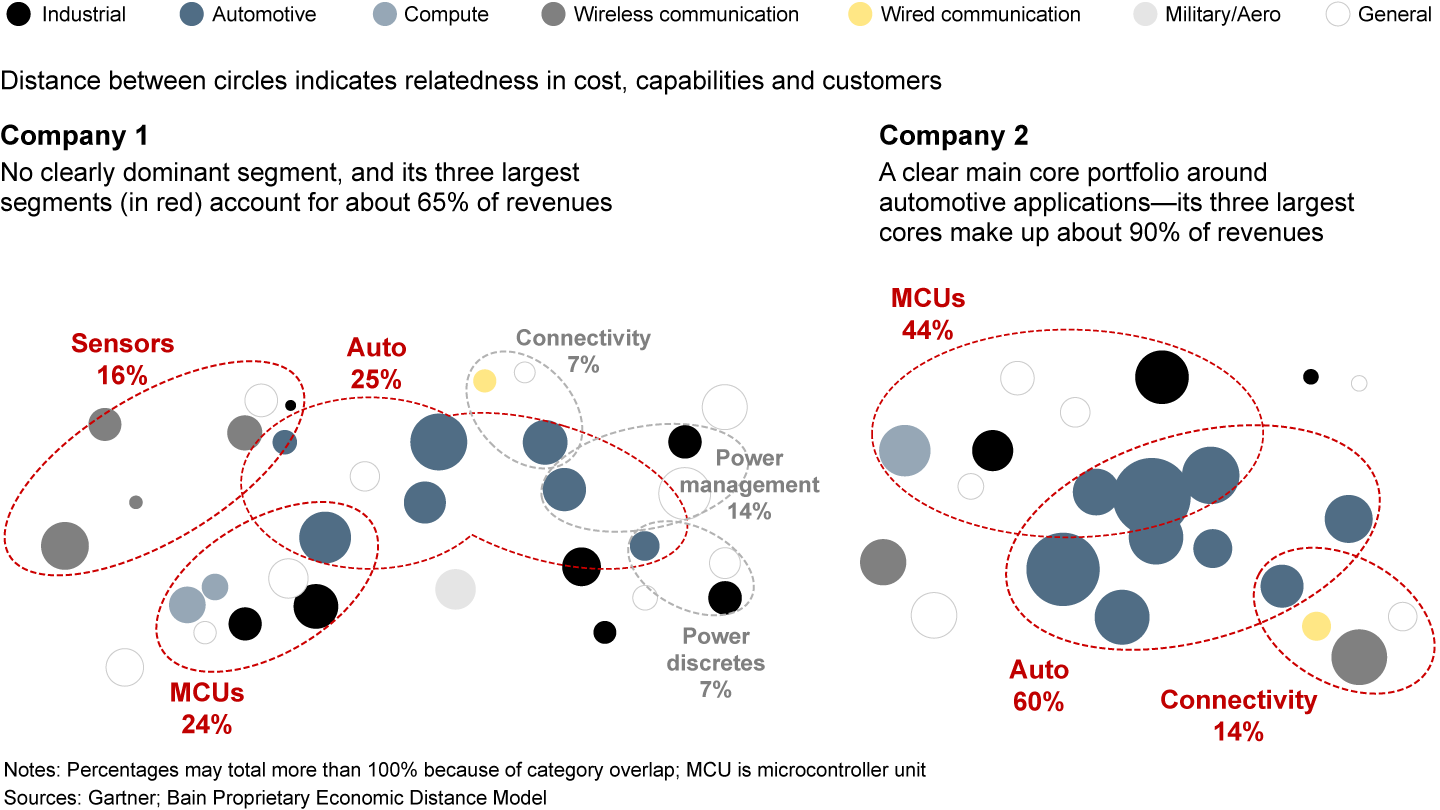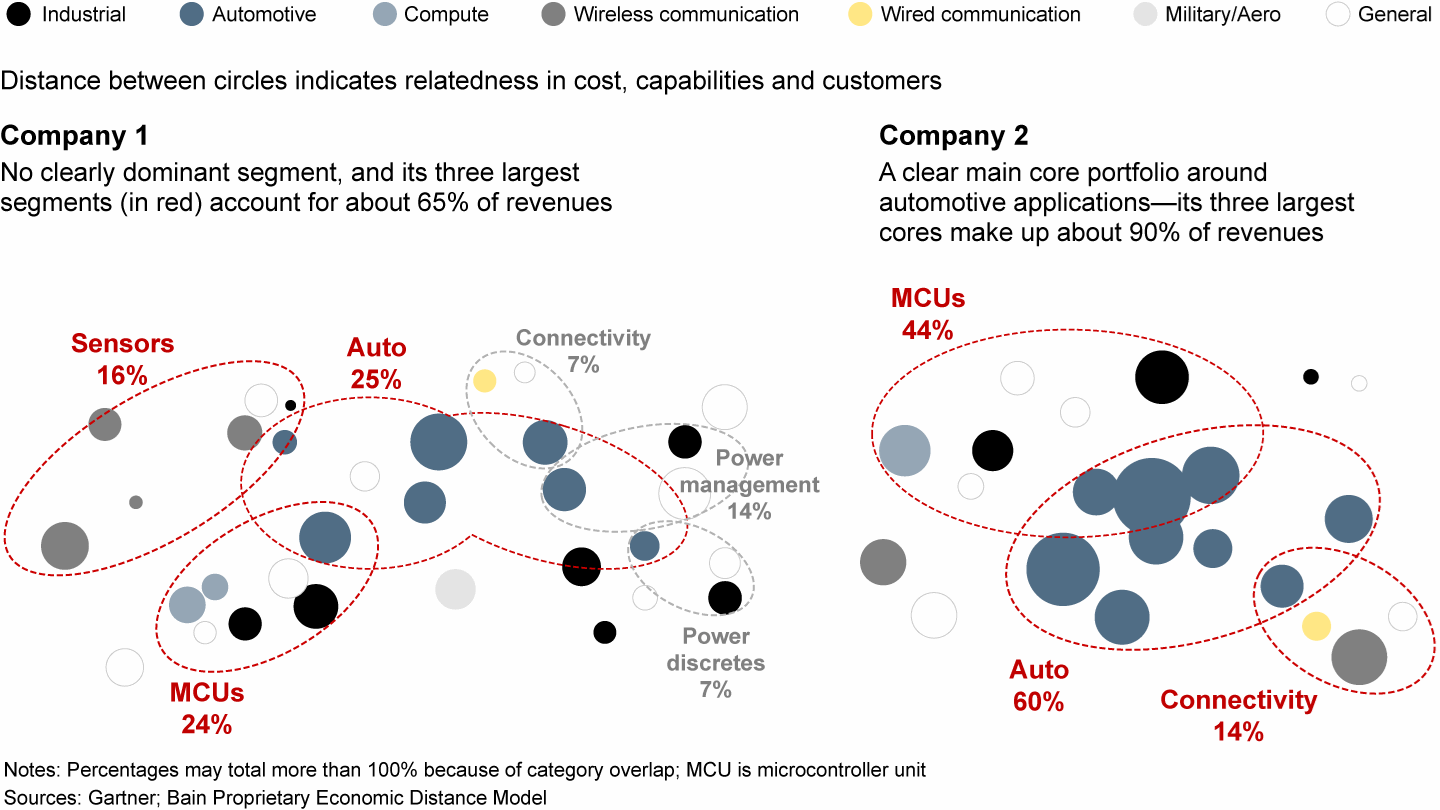Brief

Executive Summary
- In some semiconductor segments, the time is over for strategies that focus purely on products.
- A clear understanding of business boundaries has become a critical success factor for semiconductor companies.
- Some businesses require pure scale, while others require scope across applications. Strategies need to address both.
- Proactive portfolio strategies create substantial shareholder returns.
A decade’s worth of merger and acquisition activity has left many chipmakers with sprawling portfolios that include businesses outside their main areas of focus. Ideally, waves of M&A are accompanied by periods of rationalization, as companies move to divest less valuable segments of their portfolio so they can concentrate on those closer to their core. This continuous refocusing is particularly important in semiconductors, as it allows executives to focus time, talent, energy and capital on segments where they can achieve leadership and higher returns.
However, the nature of leadership is changing rapidly, and not all executives have adjusted their portfolio strategies accordingly. Companies in the semiconductor industry, like those elsewhere in the technology sector, have tended to view their portfolios primarily from a product point of view—for example, power semiconductors, sensors, microcontroller units (MCUs) or connectivity. Their M&A playbooks have reflected this, aiming to build scale within product segments they want to lead by consolidating fragmented niches to gain product leadership.
While this logic still holds true for some standard products, for others it’s no longer enough just to have scale. Increasingly, it’s important to build on product scale with expertise in the systems and applications of which the product is a part. This is particularly effective when the product sits at a control point of the system, enabling the company to build a complete reference design around it. Application-centric technology trends such as autonomous and electric cars, the Internet of Things, greater energy efficiency and renewable energy are creating new, high-growth semiconductor segments, while others like fixed and mobile communication are reaching their plateaus and commoditizing. In those application-centric segments, customers increasingly look for solutions that combine functionalities of multiple IP blocks or chips, software, reference design and ecosystem support. For example, many premium automobiles today have more than 100 electronic control units directing everything from tire pressure to electrical steering control units. Newer auto architectures tend to be based on more centralized domain controllers that steer integrated solutions of multiple chips (such as advanced driver assistance systems combining radar, lidar, vision sensors and associated logic). For these kinds of architectures, it becomes more critical for semiconductor vendors to take a full-system view that includes relevant ecosystems, rather than focusing only on individual products.
As customers' needs evolve, chipmakers must revisit their portfolio strategies and their M&A and divesture plans that support them. Previously, it was enough to gain a leading position in a product category—and for some general purpose segments, gaining scale will still be enough. But increasingly, winners are likely to be those firms that continuously refine and streamline their portfolios to complement their core positions with the capabilities necessary to deliver leading solutions, while divesting other parts of their business no longer necessary for success. Capital markets tend to favor players who take an active portfolio management approach. Unless companies fully understand the business boundaries of their portfolio and where they have the highest commercial potential, they risk misjudging their market position and the areas where they should be focusing. They may wind up investing in segments that the company cannot win or, alternatively, failing to capitalize where it has definitive strengths.
Business boundaries in the semiconductor industry have shifted
This shift in focus from products to systems has been evolving for several years, but some chipmakers still struggle to find the right approach. Executives need to invest in a new understanding of business segments in order to define their corresponding portfolio strategy, building the right scope and necessary scale to succeed in the medium and long term—not always an easy combination. With the right portfolio strategy, they can gain synergies in cost and revenue, based on overlapping customer segments, capabilities and operations.
A strategic approach to portfolio strategy begins by clearly defining the business ambition. What are the boundaries of the current business segments, where does it aspire to be and what are the odds of winning? At a detailed level, this includes identifying segment-related core competencies in customer and value chain relationships, go-to-market capabilities, supply chain management, application design and other capabilities. From there, it becomes easier to identify the synergies across competencies that are required to succeed within subsegments (see Figure 1).


Based on identified synergies across segments and capabilities, executives can begin to define boundaries and regroup businesses into market clusters—some that are specific to applications, others that are more general. For each new market cluster, executives must decide which products to include or exclude based on identified synergies.
- Cost and operational overlaps. Are there production or supply chain synergies that can be brought to bear to improve efficiency?
- Technology capabilities. Are key, differentiating R&D capabilities, intellectual property and technologies shared across product lines and market segments?
- Customer sharing. Are there customers shared among the businesses by end-market, region or size, which would allow a more effective go-to-market approach or differentiated positioning or branding?
The results of a successful portfolio transformation can be significant. One semiconductor manufacturer outperformed its peers’ total shareholder return by a factor of two on share price over a 10-year period after going through a portfolio rationalization and a cost transformation at the same time.
Building practical portfolio strategies
It’s important to keep in mind that companies rarely find acquisition targets that perfectly match their strategic needs. Acquired targets often come with their own complex portfolios, particularly in a consolidating market. Acquirers have to assess early on which parts of a target company to keep and which to divest—and streamlining should occur in parallel or soon after the acquisition. Few semiconductor players do this systematically.
Building a strategy for a complex semiconductor portfolio can be overwhelming. Breaking the problem down into six steps makes the challenge more manageable.
- Define the overall business ambition, including strategic goals and financial and growth ambitions.
- Determine core businesses based on economic business boundaries and the overlaps of costs, capabilities and customers.
- Assess the portfolio by evaluating the attractiveness (market size, growth, profitability) and ability to gain and maintain a leading position for each segment.
- Determine the full potential for each core based on current market position, as well as organic and inorganic growth opportunities.
- Build portfolio scenarios and model expected shareholder returns of various portfolio and M&A scenarios, including changes in multiples due to arbitrage, reduced portfolio risk and more attractive equity stories.
- Build multiyear roadmaps, which allow chipmakers to put in motion a proactive plan of acquisition and divestment, while assessing upcoming opportunities more quickly than competitors.
As customer preferences continue to evolve and as products become increasingly complex and multifunctional, the opportunity for chipmakers to stay competitive will depend more and more on their ability to demonstrate their mastery of complex systems and solutions. Since this requires broader capabilities than merely building scale in individual products, most chipmakers will need to make more acquisitions and divestitures in order to maintain a streamlined portfolio that delivers against their business ambitions. A more strategic approach to portfolio management can help guide their progress.
Hans Joachim Heider, Daniel Suter and Michael Schallehn are partners in Bain & Company’s Global Technology practice, and Josef Ming is a partner in the Advanced Manufacturing & Services practice. Hans Joachim is based in Munich, Daniel and Josef in Zurich, and Michael in Silicon Valley.